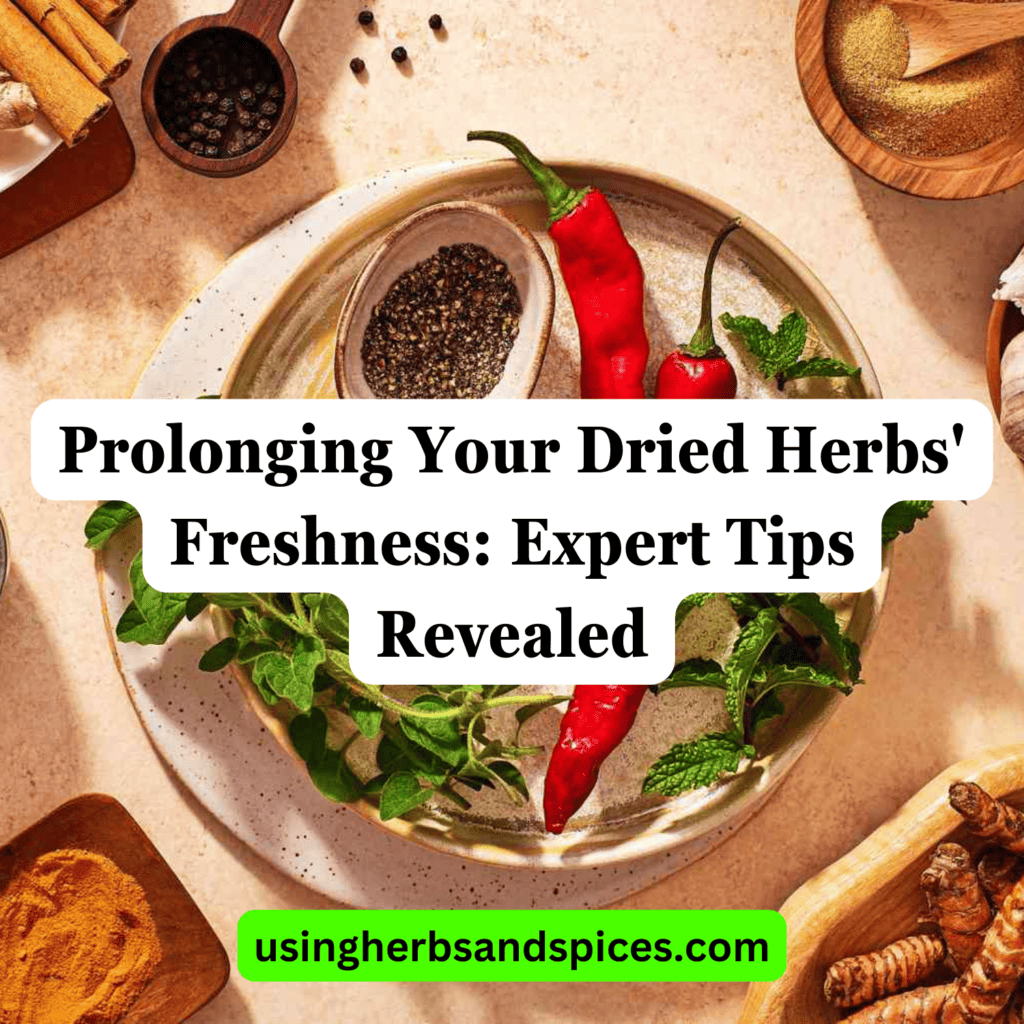You’ve probably been keeping your dried herbs right next to your bubbling cauldron—because, as everyone knows, heat and steam are their best friends. Ah, if only that were true. But fear not, you’re among friends who understand the pain of wilted basil and lackluster rosemary.

Let’s journey together through the realms of preservation with five sage tips to keep your dried herbs as fresh as the day you plucked them from the arms of Mother Earth—or the supermarket shelf. Embrace airtight containers as your new guardians, seek solace in the cool, shadowy nooks of your pantry, and become the master of humidity levels.
Remember, we’re in this together, ensuring every pinch of herbs enriches your culinary creations with the vigor and vitality they deserve.
Table of Contents
Key Takeaways
- Store dried herbs in airtight containers to prevent moisture intrusion and preserve flavors and potency.
- Use glass or metal containers instead of plastic for better protection.
- Label containers with herb name, harvest date, and source for organization and connection to growers.
- Store dried herbs in a cool, dark cupboard away from heat sources and sunlight to maintain their flavors and shelf life.
Choose Airtight Containers
To maintain your dried herbs’ potency and prevent moisture intrusion, you’ll want to store them in airtight containers. This isn’t just about keeping your herbs useable; it’s a ritual of care that ensures their flavors remain a vibrant part of your cooking circle. The choice of container materials is significant—glass or metal typically offer the best protection, preserving the integrity of your herbs. Plastic can be used, but it’s more permeable to air and may not keep the herbs as fresh for as long.
When you’ve chosen your containers, consider the importance of label codes. This isn’t mere organization; it’s a nod to the history and origin of each herb, a connection to the wider community of growers and harvesters. Your labeling system should be simple yet informative—include the name of the herb, its harvest date, and perhaps even the source. This practice isn’t just about sorting; it’s about honoring the journey from earth to table.
Store in Cool, Dark Places
Ensure your herb’s longevity by storing them in a cool, dark cupboard, away from heat sources and direct sunlight which can degrade their flavors. The place you choose to store your herbs is just as crucial as the container you put them in. Heat, light, and moisture are the adversaries of dried herbs, robbing them of their essence and reducing their shelf life significantly.
Be meticulous in your approach to herb storage. A dedicated space within your pantry could be ideal, ensuring that the temperature remains consistent and the herbs are shielded from light exposure. Remember, every time you reach for a spice while cooking, you’re exposing the rest to potential harm if they’re not stored correctly.
Incorporate herb labeling into your system. Accurate labels offer quick reference and contribute to the sense of order within your collection. It’s a small step, but it makes you feel connected to your kitchen and its treasures.
Furthermore, practice inventory rotation. Just as any well-organized pantry owner would, place newer purchases behind the older ones. This simple action ensures that none of your herbs overstay their welcome and become flavorless shadows of their former selves. This attention to detail underscores your commitment to sustaining the heartiness and spirit of your dishes.
Monitor Humidity Levels
While you’re focusing on light and temperature, don’t forget that humidity is another critical factor to consider when keeping your dried herbs fresh. Too much moisture in the air can spell disaster for the delicate flavors and medicinal properties you cherish in your herbs.
It’s essential to strike the right balance; your herbs should feel at home in an environment that’s not too humid, yet not overly dry. Think of it as creating a sanctuary for your botanical treasures, where they can remain potent and vibrant for as long as possible.
Incorporate moisture absorbers into your storage strategy. These allies work quietly in the background, maintaining an optimum level of dryness. Silica gel packets or commercially available desiccants can be placed alongside your herbs to ward off unwanted moisture.
Don’t leave humidity levels to chance. Use humidity indicators to keep a watchful eye on the environment. These handy tools can alert you to changes in moisture levels, ensuring you can react quickly to preserve your herbs’ integrity.
Refresh Your Stock Regularly
Regularly rotating your herb collection prevents staleness and maintains the zesty flavor profiles you love. Establishing a rotation schedule isn’t just about replacing old with new; it’s about ensuring the vibrancy and authenticity of your culinary creations. You’re part of a community that values freshness and the nuanced tastes that only the finest herbs can provide.
Here’s how to keep your herb cabinet as fresh as your cooking:
- Inspect: Perform monthly quality checks. Look for color changes, off smells, or any clumping that might indicate moisture.
- Label: Date your herbs when you purchase them. This will help you keep track of their shelf life.
- Plan: Use older herbs in recipes first. Incorporate them into your meal planning to minimize waste.
- Replace: Aim to refresh your stock every six months to a year, depending on the herb.
Avoid Heat and Light Exposure
You’ll maintain your dried herbs’ potency longer by shielding them from the degrading effects of heat and sunlight. Both elements can cause your herbs to lose their vibrant color and robust flavor, undermining the very essence of flavor preservation. To ensure that the seasonal variations don’t impact the quality of your herbs, store them in a cool, dark place.
A kitchen cabinet away from the oven or a pantry are ideal spots. It’s all about creating an environment where your herbs feel like they belong – away from the harsh conditions that could diminish their character.
Here’s a quick guide to help remember the essentials:
| Factor | Effect on Herbs | Storage Tip |
|---|---|---|
| Heat | Accelerates loss of flavor and color | Store in cool, dry place |
| Light | Causes fading and weakening of essential oils | Keep in opaque containers |
| Air | Can lead to staleness and moisture | Use airtight containers |
Stick to these meticulous guidelines, and you’ll ensure that every pinch of herb you sprinkle into your cooking retains its authentic charm. Remember, your culinary creations deserve the best, and that starts with how you care for your seasonings. Flavor preservation isn’t just a practice, it’s a commitment to the art of cooking.
Frequently Asked Questions
Can I Extend the Freshness of Dried Herbs by Freezing Them?
Yes, you can extend your dried herbs’ shelf life by freezing them. This freezing methodology helps in aroma retention, ensuring they stay fragrant and potent for your cherished family recipes.
Is There a Difference in Shelf-Life Between Home-Dried and Store-Bought Dried Herbs?
You’ll often find that home-dried herbs, carefully dehydrated, boast a longer shelf-life due to higher quality factors compared to store-bought counterparts that may have lost their essence through longer storage and handling.
How Can I Tell if My Dried Herbs Have Gone Bad or Lost Their Potency?
You’ll notice your dried herbs have lost potency if they’ve faded in color or have a musty smell. Proper herb storage is key to maintaining their robust flavor and aromatic qualities.
Are There Any Natural Desiccants That I Can Use to Help Keep My Dried Herbs Dry?
Yes, you can use natural desiccants like rice packets or silica gel to keep your dried herbs dry, ensuring they remain a vibrant part of your culinary community for longer.
Can I Revive Dried Herbs That Have Started to Lose Their Aroma?
You can’t resurrect the full vibrancy of wilted blooms, but you can rehydrate herbs to partially restore their aroma. Gently steam them to coax out subtle scents, achieving a semblance of their former glory.
Tips to Extend Dried Herbs’ Freshness
Imagine your dried herbs as treasured books on a shelf. Just as sunlight and moisture can warp and fade a cherished novel’s pages, your herbs are vulnerable to the elements.
By stashing them in airtight containers, tucked away in cool, dark corners, you safeguard their vibrant tales of flavor.
Keep them dry, rotate your aromatic library often, and shield them from the harsh glare of the kitchen spotlight.
Your culinary stories will remain as vivid and flavorful as the day they were penned.









